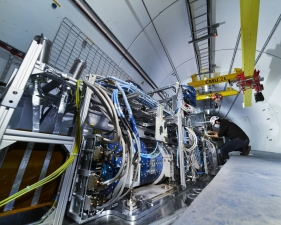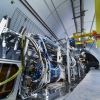Progress and future of the neutrino research program at the LHC
2022.11.21 11:04 - Piotr Spinalski
 The next period of LHC operation, which began this year, has inaugurated a new research direction at the Large Hadron Collider. It concerns the measurement of high-energy neutrinos, the study of the nature of interactions that bind atomic nuclei together, and the search for traces of so-called new physics. On November 15–16, during the 5th international meeting, the operation of the new FASER and SND@LHC detectors was initially summarized and future plans were discussed, including plans to build new facilities.
The next period of LHC operation, which began this year, has inaugurated a new research direction at the Large Hadron Collider. It concerns the measurement of high-energy neutrinos, the study of the nature of interactions that bind atomic nuclei together, and the search for traces of so-called new physics. On November 15–16, during the 5th international meeting, the operation of the new FASER and SND@LHC detectors was initially summarized and future plans were discussed, including plans to build new facilities.
Thanks to their elusive nature, neutrinos are a unique source of information about processes occurring under extreme conditions in, for example, the very early Universe or in the interiors of stars. Because they interact very weakly with matter, neutrinos carry information from places that cannot be studied by other methods. As a result, they provide a window into understanding very rare events that would otherwise be drowned in a sea of other physical processes. The study of neutrinos makes it possible to look at the nature of such processes from a safe distance and indirectly deduce about the nature of the fundamental interactions themselves, as a result of which neutrinos were created.
This basic feature of neutrinos is now also being used to analyze the results of proton collisions at the LHC. The FASER and SND@LHC experimental collaborations conduct measurements of neutrino interactions produced in the direction along the axis of colliding protons to better understand the course of their production at the collider. This allows, among other things, a better link between the results obtained at the LHC and the puzzles involved in observing the constant collisions of cosmic rays with the Earth’s atmosphere. This research also provides insight into other issues related to the structure of strong interactions, manifested both in proton collisions and in neutrino interactions themselves in detectors.
At the meeting, scientists from around the world discussed the proposed expansion of the neutrino program during the LHC’s future operating period and the creation of a dedicated new tunnel (Forward Physics Facility, FPF) for this purpose. The data collected there will allow analysis of up to more than a million neutrino interactions, with high-precision measurements based on a highly focused, high-energy beam of these particles. Among the several experiments proposed for inclusion in the FPF are improved versions of current detectors, as well as new research instruments, including the liquid-argon FLArE detector. The idea was originally proposed in a theoretical paper, one of the authors of which is PhD. Sebastian Trojanowski of the AstroCeNT center, CAMK PAN and the NCBJ Department of Theoretical Physics. The paper deals with possible methods of searching for light dark matter particles at the LHC. Currently, this idea is being developed in several centers around the world, with Brookhaven National Laboratory in the US taking the lead.
The proposed FLArE experiment is another example of a neutrino detector that will also be able to be used to look for traces of new physics, particularly one that can manifest at energies suitable for the LHC. „How quickly our ideas are evolving and how broadly they are gaining traction in the scientific community is an extremely strong incentive to continue our work,” says PhD. Trojanowski, who along with Prof. Brian Batell of the University of Pittsburgh in the US, are chairmen of a working group at the FPF dedicated to research on so-called new physics. „Linking an incisive program of guaranteed physical measurements to a broad field of possible new scientific discoveries, which as always are more speculative in nature, is particularly appealing to me and the many physicists involved. We look forward with curiosity to further results from the current FASER and SND@LHC detectors, as well as on the lookout for opportunities to continue this program in the future of collider operations."
The work on the research program at the LHC, carried out by a group led by PhD. Trojanowski in the NCBJ’s Department of Theoretical Physics, is co-financed by the National Science Center’s grant „Study of light particles of the dark sector of the Universe” awarded under the SONATA BIS program (which we wrote about here: https://old.ncbj.gov.pl/aktualnosci/dwie-nowe-sonaty-bis-zakladzie-fizyki-teoretycznej).

















